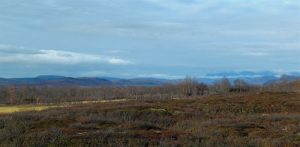
A peatlands sampling site near in Kilpisjärvi, Finnish Lapland. (Photo Credit: Carolina Voigt)
Temperatures in the Arctic are rising twice as fast as in the rest of the world, causing permafrost soils to thaw. Permafrost peatlands are biogeochemical hot spots in the Arctic as they store vast amounts of carbon. Permafrost thaw could release part of these long-term immobile carbon stocks as the greenhouse gases carbon dioxide (CO2) and methane (CH4) to the atmosphere, but how much, at which time-span and as which gaseous carbon species is still highly uncertain.
A new study led by researchers from the University of Eastern Finland and the University of Montreal, in cooperation with researchers from various Nordic research institutions, finds that peatlands may strengthen the permafrost-carbon feedback by adding to the atmospheric CO2 burden post-thaw. The study was recently published in Global Change Biology.
